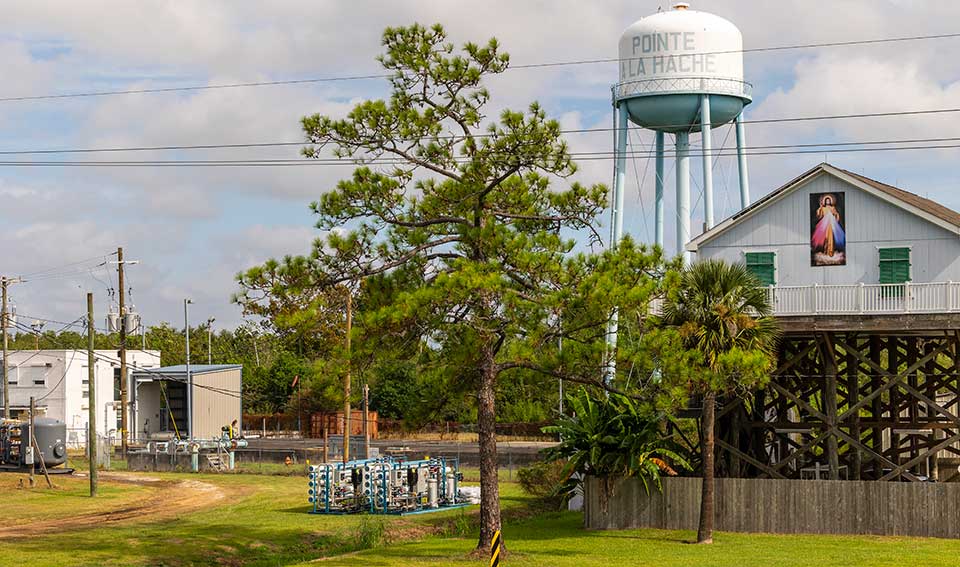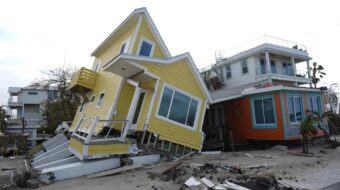
NEW ORLEANS—Residents in the southern Louisiana parish of Plaquemines were left thirsty this summer after saltwater started flowing from their kitchen taps.
In late June 2023, saltwater from the Gulf of Mexico moved up into the Mississippi River and began to impact the drinking water supply for communities located in Plaquemines Parish. This phenomenon, known as a saltwater wedge or saltwater intrusion, raised the salt content of the drinking water in the area, forcing residents to rely on bottled water.
Typically, a saltwater intrusion would be contained to lower Plaquemines communities such as Venice, Buras, Boothville, Empire, Bohemia, etc. When a saltwater intrusion occurs, the U.S. Army Corps of Engineers (USACE), the federal agency tasked with managing the river to ensure it can be navigated by cargo ships, is usually quick to build a structure in the river known as a “sill” to prevent the saltwater from moving up river.
However, it has been announced by USACE officials that the sill has failed to contain the saltwater. This means, depending on how the situation develops, every water production plant within the southeast Louisiana region (including New Orleans) could be inundated with saltwater and unable to provide clean drinking water to residents. The situation is serious enough that the mayor of New Orleans has issued an emergency declaration to address it.
In order to properly understand this saltwater intrusion event, we need to look at what caused it, what efforts are being taken to mitigate its impact, and how this situation could develop over the coming weeks and months.
There are multiple contributing factors both causing the current situation and intensifying it. The primary factor most often pointed out by USACE officials and the Louisiana state government is the exceptionally low water levels of the Mississippi River.
According to a gauge that measures river height located in St. Louis operated by the USACE and the U.S. Geological Survey, the water level at that location was -3.53 feet on September 19. While this is an exceptionally low level for the area, the readings fluctuate based on the location from which the data is collected.
For example, the water level monitoring gauge in New Orleans measured the river height at 1.77 feet on the same day. Nevertheless, though some sections of the river may be higher or lower than others due to specific conditions of that area, the general state of the river’s water level is that it is much lower than average.
When the Mississippi River’s water levels drop so drastically, there is a corresponding drop in its flow rate. USACE acting chief of the New Orleans district office Dana Ray reported that the river flow rate has dropped to as low as 130,000 cubic feet per second. Though the Mississippi River has an average flow rate of around 593,000 cfs, it is capable of reaching over 1 million cfs at its strongest. So, it mustn’t be understated just how weak 130,000 cfs is.
It must be pointed out that these two conditions, low river and weak river flow, are not an uncommon occurrence for the region—even saltwater intruding into the Mississippi River has occurred at several points in the recent past. But the current situation is unique not just for its intensity and potential scope of impact, but also the time of year in which it’s occurring. Typically, the Mississippi River’s water level and flow rate will drop in the late fall and early winter months due to winter freezes and drier weather conditions.
This year, however, exceptional drought conditions throughout the country caused the development of the low river and weak flow rates much earlier than expected. This drought has only been intensifying over the summer, with nearly all of Louisiana and a good portion of Texas now experiencing “Exceptional Drought.”
The drought, the low water levels, and a weak flow rate form the primary force driving the saltwater intrusion, all helping to create the conditions possible to allow this event to occur at the current level of intensity. But these are not the only reasons saltwater has been so eagerly crawling up the banks of the Mississippi River.
Local officials and residents of Plaquemines Parish have stated—upon multiple different occasions—that several diversions that have formed along the east bank of the lower Mississippi River are also partially to blame. A “diversion” in the Mississippi River is, essentially, a hole that has been cut through (whether it’s done naturally by the force of the river or deliberately by people to achieve some end) the river’s banks allowing water to flow into the surrounding marsh ecosystems.
These diversions in the lower Mississippi River include Mardi Gras Pass, Neptune Pass, and Baptiste Collete, amongst others. Each of these diversions varies in terms of their size and the amount of water they move, but, taken all together, these diversions pull away about 50 percent of the river’s flow. Neptune Pass itself takes around 16 percent of the flow, moving 118,600 cfs of water.
Though these diversions are hailed by environmentalists as effective means to rehabilitate decaying marsh ecosystems in the area, residents of Plaquemines hold that the diversions result in many harmful consequences, such as leaving their communities susceptible to saltwater intrusion events.
With these factors impacting the Mississippi River all at once—the drought, the low river, the weak flow rate, the diversions along the lower sections of the river, and the failure of the USACE sill—saltwater from the Gulf of Mexico will be able to travel into the river with little resistance.
A similar situation occurred in 1988. Instead of a sill failing, though, USACE completely missed the opportunity to install a sill at all. At that time, saltwater was able to travel all the way to the Carrollton Bend by Kenner, La. If the current situation were to mirror that one, it would mean that the water plants in Belle Chasse, St. Bernard Parish, Orleans Parish (New Orleans), and even Jefferson Parish would be impacted.
In response to this possibility, government agencies have already begun the process of implementing various mitigation efforts, including having USACE barge in water to use in water plants, bringing in additional bottled water, implementing reverse osmosis machines to remove salt from the water, and interconnecting parish water systems to allow plants less impacted by the intrusion to send water to those more impacted. The major concern of the region is that this saltwater intrusion reaches Carrollton Bend like it did in 1988 or goes beyond it.
While there have been assurances from Louisiana Gov. John Bel Edwards that the situation will be controlled and that there’s plenty of bottled water for people to buy, it is unclear exactly how intense the impact from the saltwater intrusion will be.
When a saltwater intrusion is contained to the southern reaches of the Mississippi River, thus only impacting lower Plaquemines communities, mitigation efforts are fairly effective. To be certain, it’s still a dire situation for those who live in those communities and deserves a high degree of attention from local, state, and federal government agencies. But the response is at a much smaller scale—with only a few hundred people being impacted—and is well within the capacity of these agencies.
The current saltwater intrusion has the potential to leave millions of people without fresh drinking water. The Louisiana Department of Health notes that the chloride within salt (sodium chloride) is the most dangerous aspect of it entering into drinking water supplies, with amounts exceeding 250 milligrams per liter becoming harmful to health.
If the drinking water supply of New Orleans and Jefferson becomes inundated with amounts at or beyond that 250 mg/L level, then the response from the state and federal government could prove to be ineffective. Such a situation has not occurred in recent times. Even during the 1988 saltwater intrusion event, salt levels at the Jefferson and New Orleans water plants remained relatively low.
Of course, this is all dependent on whether the drought continues, whether water levels and flow rate of the river remain low, and whether the saltwater intrusion itself continues to travel upriver. In the worst-case scenario, residents of New Orleans and the entire southeast Louisiana region could soon find themselves forced into relying on buying bottled water for weeks or even months.












Comments